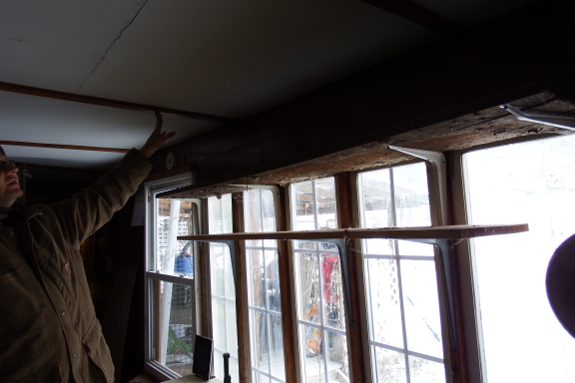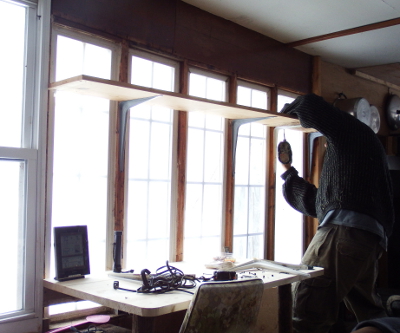
Cleaning up my seed-starting act

The weakest link in our
current gardening year is seed starting. We often lose seedlings to
damping off or just to general legginess, to the extent that I sometimes
miss whole planting windows due to lack of transplants.
The crazy part is that
I've known the source of the problem for years; I've just been too
stubborn to use electricity to fix it. Here's the deal: even right up
against our south-facing bank of windows, seedlings just don't get
enough light inside in the winter months due to cloudiness and short
days. And without enough light, they fail to thrive.
 About
five years after figuring this out, I told my husband. Within two days,
Mark had determined just the right spot to place a plant shelf while
leaving space above to mount shop lights and a fan for optimal results.
About
five years after figuring this out, I told my husband. Within two days,
Mark had determined just the right spot to place a plant shelf while
leaving space above to mount shop lights and a fan for optimal results.
I suspect once he reads
this post and finds out that I'd get even better results if I expanded
beyond the single heating pad grudgingly purchased a few years ago for jumpstarting sweet potato sprouts, I'll wind up with even more electricity use in my seed-starting area.
Yes, it feels
not-quite-sustainable to be using electricity to start seeds. On the
other hand, given the huge quantities of food we grow and the small
addition we'll likely be adding to our monthly electric bill, I think
this compromise probably makes sense.
And now I'm dying to sprout some seeds!
Want more in-depth information? Browse through our books.
Or explore more posts by date or by subject.
About us: Anna Hess and Mark Hamilton spent over a decade living self-sufficiently in the mountains of Virginia before moving north to start over from scratch in the foothills of Ohio. They've experimented with permaculture, no-till gardening, trailersteading, home-based microbusinesses and much more, writing about their adventures in both blogs and books.
Want to be notified when new comments are posted on this page? Click on the RSS button after you add a comment to subscribe to the comment feed, or simply check the box beside "email replies to me" while writing your comment.

I've been using lights and a fan to start seeds for a couple of years now, and I'm amazed at how much better results I get! I have multiple shop lights hanging, plus the fan, so I plug them all into a power strip. Then I plug that into a cheap outlet timer, connected to the actual outlet, so that everything comes on and turns off at the times that I want. It requires a bit of setup, but is a time saver in the long run, and I get consistent results with very little effort on my part!
I also have a heat mat, and it does seem to germinate my seeds faster, but I can't decide if it's worth getting a second one. I can fit two seed starting trays on it, and I only use it for germination and then rotate new trays onto it once the seeds have sprouted. So as long as I don't mind staggering my germination and thus having different height lights for a while as they grow, I can use one pad to germinate all my trays.
I had the same problem for the same reason. The south facing window simply doesn't have enough light. I went to Lowes a few years ago, bought some $15 each fluorescent lights and put them on top of the seedlings. That kinda did okay but then I notice my neighbor, who was doing the same thing in a house that he keeps dark (for reasons that make no sense to me) had his lights practically on top of the seedlings. Guess what? They thrived like nobody's business and looked better than the seed starts you get from Lowe's or Tractor Supply. So I added lights to all my seed trays this year.
Also found a better heat mat on Ebay called "Heat-Sprout Seedling Seed Heat Mat Sprouting Propagation Germination - 4 Sizes". Just plug name into Ebay's search engine.
I've found this kind of seedling heating mat puts out 90 degrees but since the mat is under a plastic bin which contains dirt and seeds, the heat there is at 70 degrees. Perfect temp for starting seeds!
Compared to old-fashioned incandescent lights which yields 15-20 lm/W (lm is the standard symbol for lumen), a fluorescent light gives 70 lm/W. White LEDs yield in the order of 60-100 lm/W. High-pressure sodium yield 100-150 lm/W (the higher figure is for a 600W lamp; probably a little big for your trailer ).
).
So the right light means a little electricity can go a long way. But LED are semiconductors which need a lot of infrastructure and resources to make. Sodium lights contain sodium and mercury which are both hazardous when released, so they need to be recycled properly at their end-of-life. Is any of those sustainable?
You could of course use a solar panel and batteries to "store" light. In practice (because of co$t) this would mean lead-acid batteries which need proper recycling because of the toxicity of lead. And solar cells are also semiconductors with basically the same disadvantages as LEDs.
We seem to be getting closer to the point where PV electricity will reach cost parity with grid power. But I'm not sure if you could call it sustainable.
In the end one could ask if any human civilization is sustainable in the long term. Even prehistoric hunter-gatherers would exhaust their environment. But in a low population density environment they had the option to relocate.
Such things can be debated until our Sun swells up and bakes our planet in a couple of billion years.
I'd say find some good LED growing lights and use them.
Hi All,
I gotta wonder if putting florescent lights close to the trays makes the electric field MUCH higher and that is the real effect of putting the lights on top of the plants?
John